|
It
happened that the Prophet Joseph Smith’s epistle to the Church,
written while he was in hiding, -
“the word of the Lord”
indicating the
western NY location of the Book of Mormon
land
Cumorah, was printed in the same Times and Seasons
issue as the “ZARAHEMLA” piece.
The
“ZARAHEMLA” article (an overreaching extrapolation on
Stephens’ 1841
Incidence of Travel in Central America) proclaimed the stone ruins
at
Quirigua
to belong to the Book of Mormon
city
Zarahemla.
What
some authors and tour guides don’t want you to know is that the Quirigua
Zarahemla idea was eventually abandoned by the very apostles
(John Taylor
and
Wilford Woodruff) who ran the Nauvoo
printing establishment at the time the “ZARAHEMLA” article came out – that was during Joseph Smith’s
public absence. These same brethren (with the Quorum of the Twelve) would
later throw their support behind Orson Pratt’s far-flung South American Zarahemla idea. (See footnotes to the
1879 LDS edition of the
Book of Mormon; e.g. Alma 22:31 footnote 2q)
Orson Pratt had been excommunicated a little before the “ZARAHEMLA” piece was
published. Elder Pratt was later reinstated as an apostle. Neither John
Taylor nor Wilford Woodruff ever attributed the Quirigua idea to Joseph
Smith, and there is evidence that at the time the “ZARAHEMLA” piece came
out, neither of these apostles had read Stephens’ 1841 bestseller as well as
Joseph had. [1] Had they done so, they may have taken more
seriously the
Quirigua claim’s
anachronism.
Had
early members of the Church, in general, paid more attention to scriptural
details
(LDS D&C 84:54-59),
more might have realized that the Book
of Mormon’s literary setting cannot accommodate either a Guatemalan
or a South American Zarahemla (both pure Mormon speculation) since Cumorah
resides in western New York
(LDS D&C 128:20)!
According to the Book of Mormon, Zarahemla was so near “a land among
many waters” (Finger Lakes region) that travelers from southern
highlands sincerely thought they had found Zarahemla when they had wandered
into a place not far from Cumorah.
(Mosiah 8:7-8;
21:25-26,
Mormon 6:4,
Ether 9:3)
So it isn’t that ancient peoples couldn't have travelled long
distances, its simply that Cumorah and Zarahemla were so near to each other
that ruins near Cumorah could be mistaken for Zarahemla.
As you
critically read the “ZARAHEMLA” article, in light of its historical
context, the smoke from tourism and media interests should clear for you,
and the ridiculousness of basing the Book of Mormon's literary setting on the newspaper article in lieu of
LDS scripture, should become
apparent. So here it is - the much touted “ZARAHEMLA” article in its
entirety (commentary in true blue):
TIMES AND SEASONS
"TRUTH WILL PREVAIL."
VOL.
III. NO. 23.] NAUVOO, ILLINOIS, OCT. 1, 1842. [WHOLE NO. 59
ZARAHEMLA.
Since
our 'Extract' was published from Mr. Stephens' 'Incidents of Travel,' &c.,
we have found another important fact relating to the truth of the Book of
Mormon. Central America, or Guatimala
[Guatemala], is situated north of the
Isthmus of Darien and once embraced several hundred miles of territory from
north to south.-The city of Zarahemla, burnt
[timber city] at the crucifixion of the Savior, and rebuilt
[the Book of Mormon does not say of hewn
stone;
4 Nephi 1:7-8,
Mormon 5:5]
afterwards, stood upon this land as
will be seen from the following words in the book of Alma:-'And now it was
only the distance of a day and half's journey for a Nephite, on the line
Bountiful, and the land Desolation, from the east to the west sea; and thus
the land of Nephi, and the land of Zarahemla was nearly surrounded by water:
there being a small neck of land between the land northward and the land
southward.' [See Book of Mormon 3d edition, page 280-81.]
Note the use of “our” and “we”. John Taylor and Wilford Woodruff were
running the Nauvoo printing establishment. The Prophet was official editor
of the newspaper (in name) but had “left his affairs with agents and clerks”
who were to “transact all business…” until “the storm”
(charges relating to
the Boggs incident) was “fully blown over”. Only then would the Prophet
fully resume pubic life.
(LDS D&C 127:1) Until then, Joseph was ready
to leave the city on a moments notice - free of any business obligations.
There is no mention of John Lloyd Stephens or his work in Joseph Smith’s
journal – none! HC 5:44 is a
redaction (a well meaning fabrication)! If you are willing to risk getting a
little disgusted with
HC 5:44, go to the
Prophet’s Journal (25 June 1842 - Saturday) and
compare the two accounts. Note: Joseph’s Journal account was entered by a
clerk or secretary
(Willard Richards). That is why the Prophet is referred to in the third person in the
original.
Wilford Woodruff’s Journal on the other hand has several exuberant mentions
of Stephens’ works; though Elder Woodruff had only “perused” Stephens’ second
volume. (See Wilford Woodruff’s Journal, September 16, 1841; 2:126)
Joseph had by November 1841, thoroughly read both volumes of Stephens’
bestseller “with the greatest interest”. [1]
Joseph
could therefore not have missed Stephens’ conclusion that the Central
American stone ruins were not of great antiquity but were of “COMPARATIVE
MODERN DATE…” (Incidents of Travel in Central America, Vol. II,
Chapter XXVI, “COMPARATIVE MODERN DATE OF RUINS”, pp. 442-443)
Joseph was pleased to find that Stephens’ bestseller addressed more than
Central American discoveries. Many don’t know that Stephens also wrote
about the mound builders of North America!
Joseph read Stephens’ historical summary of “antiquities pertaining to
this country” and thought Stephens history more “correct luminous &
comprehensive” than Priest’s American Antiquities and Discoveries in the
West. [1, 2]
Even so, Joseph published several editorials
drawing from Priest’s work - just before the Boggs’ incident hit. Though
Joseph relied heavily on American Antiquities for material support of
the Book of Mormon, it was not without misgivings. For one thing,
Priest had written critically about the Book of Mormon! Joseph Smith’s
American Antiquities editorials parallel Stephens’ list of discoveries
made in the United States of America. [2]
Did you catch that the isthmus mentioned in the “ZARAHEMLA” article is “the
Isthmus of Darien” at
Panama? There is no mention of the wide,
lateral Isthmus of Tehuantepec
– the isthmus that recent Central American "Book of Mormon
geography" models entertain. The broad
Mexican isthmus cannot be crossed in a day and a half on foot! Will somebody
please try and prove this statement wrong by making the attempt? Isn’t there one BYU athlete
who will try?
The “ZARAHEMLA” article seems to be making a connection between the Book
of Mormon “small neck of land between the land northward and the land
southward” and the Panamanian isthmus separating North and South America.
Sure the anonymous authors understood that Guatemala is north of the isthmus at Panama, but they seem to confuse “the narrow
strip of wilderness” south of Zarahemla
(Alma 22:27) with
the “small neck of land” north of Zarahemla.
(Alma 22:30-33;
50:34;
52:9;
63:5,
Mormon 2:29;
3:5,
Ether 10:20-21)
Hello! Zarahemla cannot be in Guatemala
if Panama’s
Darien Isthmus is the Book of Mormon small neck of land. If the small neck is at Panama
then Zarahemla would have to lie in South America – not Guatemala. Not surprisingly, in
a previous unsigned extract article, the anonymous authors placed the
patriarch Lehi's landing
"a little south of the Isthmus of Darien"! Where?
In South America?
In time the authors looked a little more into whether Zarahemla was
north or south of the Book of Mormon small neck, and this may be one
of the reasons why both John Taylor and Wilford Woodruff later gave their
support to Orson Pratt’s South American Zarahemla idea, featured in the
footnotes of the
1879 edition of the Book of Mormon.
Orson Pratt, by the way, placed Lehi's landing far to the south on the coast
of Chile.
In any event, the blundering “ZARAHEMLA” piece is clearly not
the word of the Lord through Joseph Smith. The
newspaper article is simply a work of
well-meaning speculation. It is about as authoritative and reliable as a
sasquatch sighting published in a supermarket tabloid! Think that’s harsh?
Read on:
It is
certainly a good thing for the excellency and veracity, of the divine
authenticity of the Book of Mormon, that the ruins of Zarahemla have been
found where the Nephites left them: and that a large stone with engravings
upon it as Mosiah said; and a 'large round stone, with the sides sculptured
in hieroglyphics,' as Mr. Stephens has published
[Catherwood’s account], is also among the left
remembrances of the, (to him,) lost and unknown. We are not going to declare
positively that the ruins of Quirigua are those of Zarahemla, but when the
land and the stones, and the books tell the story so plain, we are of
opinion, that it would require more proof than the Jews could bring to prove
the disciples stole the body of Jesus from the tomb, to prove that the ruins
of the city in question, are not one of those referred to in the Book of
Mormon.
So go ahead and publicly announce that “the ruins of Zarahemla have been
found where the Nephites left them” and then add a disclaimer!
There isn’t a hint of concern in the article that the Quirigua ruins
may
not date to Book of Mormon times. Wouldn’t it have been a good idea
to at least look into and report Stephens’ take on the date of the
ruins? Of course, that might mean digesting both volumes of Stephens work as
Joseph Smith had. The anonymous authors might have applied themselves to study (characteristic of
notable Jewish scholars)
but for the fact that the T&S had to meet its schedule!
Don’t forget that Joseph thought highly of Stephens’ history of “the
antiquities of this country” and pronounced Stephens history “most correct”.
[1, 2]
There is
no indication that Joseph Smith thought Stephens was egregiously wrong about
the age of the Mesoamerican ruins. Other authors before Stephens (e.g.
Ethan Smith and
Josiah Priest)
had reached similar conclusions. They also regarded
Mexico’s and Central America’s
ruins as relatively recent works.
But despite (or oblivious to) any anachronism, the anonymous authors of the
“ZARAHEMLA” piece sought to coerce a connection between a carved stone
documented by Stephens’ associate Frederick Catherwood, and a large stone
with engravings on it mentioned in the Book of Mormon - in fact, the
only large engraved stone mentioned in the Book of Mormon. The
article blunders by attributing the
account of the large inscribed stone to “Mosiah”. According to the Book
of Mormon, the account of king Mosiah having a large engraved stone brought
to him (transportable enough to have been brought to the king, and not
the king to the stone), was actually recorded by Amaleki the son of Abinadom.
(Omni 1:12,
20)
Were ancient copper working and mound building peoples of the Great Lakes region incapable of carving on stone? Must we
choose one of the many carved stones at Quirigua to answer for the Book of
Mormon’s “large stone”? If so, have the anonymous T&S authors
been vindicated? Do any of Quirigua’s carved stones give “an account of one
Coriantumr, and the slain of his people…”?
(Omni 1:21)
Crushingly, the answer is no! All of the Quirigua carved stones are late classic Mayan
(centuries later than Coriantumr of the Book of Mormon). None of the
inscriptions on them have any thing to do with the Jaredite ruler or the
fall of his people. The “ZARAHEMLA” article’s proposition
has turned out to be embarrassingly false.
Finally, as you read the article’s ironic conclusion, see if you
think the first sentence is hinting that God preserved the Central
American ruins so miraculously well, that “unbelievers” (reasonable folk like Stephens)
might mistakenly think them to be almost contemporary?
It may
seem hard for unbelievers in the mighty works of God, to give credit to such
a miraculous preservation of the remains, ruins, records and reminiscences
of a branch of the house of Israel
[Exodus 20:24-26,
faithful Israelites did not sacrifice on hewn stone altars, or on altars with
steps!]: but the elements are eternal, and intelligence is eternal,
and God is eternal, so that the very hairs of our heads are all numbered. It
may be said of man he was and is, and is not; and of his works the same, but
the Lord was and is, and is to come and his works never end; and he will
bring every thing into judgment whether it be good, or whether it be evil;
yea, every secret thing, and they shall be revealed upon the house tops. It
will not be a bad plan to compare Mr. Stephens' ruined cities with those in
the Book of Mormon
[there is no explicit mention
of hewn stone buildings in Book of Mormon America –
earth, timber
and
cement,
yes!]: light cleaves to light, and facts are supported by
facts. The truth injures no one
[misguided egos
and business interests excepted],
and so we make another
EXTRACT
From
Stephens' "Incidents of Travel in Central America."
"On a
fine morning, after a heavy rain, they set off for the ruins. After a ride
of about half an hour, over an execrable road, they again reached the
Amates. The village was pleasantly situated on the bank of the river, and
elevated about thirty feet. The river was here about two hundred feet wide,
and fordable in every part except a few deep holes. Generally it did not
exceed three feet in depth, and in many places was not so deep; but below it
was said to be navigable to the sea for boats not drawing more than three
feet water. They embarked in two canoes dug out of cedar-trees, and
proceeded down the river for a couple of miles, where they took on board a
negro man named Juan Lima, and his two wives. This black scoundrel, as Mr.
C. marks him down in his notebook, was to be their guide. They then
proceeded two or three miles farther, and stopped at a ranch on the left
side of the river, and passing through two cornfields, entered a forest of
large cedar and mahogany trees. The path was exceedingly soft and wet, and
covered with decayed leaves, and the heat very great. Continuing through the
forest toward the northeast, in three quarters of an hour they reached the
foot of a pyramidal structure like those at Copan, with the
steps in some places perfect. They ascended to the top, about
twenty-five feet, and descending by steps on the other side, at a short
distance beyond came to a colossal head two yards in diameter, almost buried
by an enormous tree, and covered with moss. Near it was a large altar, so
covered with moss that it was impossible to make anything out of it. The two
are within an enclosure.
Retracing their steps across the pyramidal structure, and proceeding to the
north about three or four hundred yards, they reached a collection of
monuments of the same general character with those
(page
927)
at
Copan, but twice
or three times as high.
The
first is about twenty feet high, five feet six inches on two sides, and two
feet eight on the other two. The front represents the figure of a man, well
preserved; the back that of a woman, much defaced. The sides are covered
with hieroglyphics in good preservation, but in low relief, and of exactly
the same style as those at Copan.
Another,
represented in the engraving, is twenty-three feet out of the ground, with
figures of men on the front and back, and hieroglyphics in low relief on the
sides, and surrounded by a base projecting fifteen or sixteen feet from it.
At a
short distance, standing in the same position as regards the points of the
compass, is an obelisk or carved stone, twenty-six feet out of the
ground, and probably six or eight feet under, which is represented in the
engraving opposite. It is leaning twelve feet two inches out of the
perpendicular, and seems ready to fall, which is probably prevented only by
a tree that has grown up against it and the large stones around the base.
The side toward the ground represents the figure of man, very perfect and
finely sculptured. The upper side seemed the same, but was so hidden by
vegetation as to make it somewhat uncertain. The other two contain
hieroglyphics in low relief. In size and sculpture this is the finest of the
whole.
A statue
ten feet high is lying on the ground, covered with moss and herbage, and
another about the same size lies with its face upward.
There
are four others erect, about twelve feet high, but not in a very good state
of preservation, and several altars so covered with herbage that it
was difficult to ascertain their exact form. One of them is round, and
situated on a small elevation within a circle formed by a wall of stones. In
the centre [center] of a circle, reached by descending very narrow steps, is
a large round stone, with the sides sculptured in hieroglyphics,
covered with vegetation, and supported on what seemed to be two colossal
heads.
These
are all at the foot of a pyramidal wall, near each other, and in the
vicinity of a creek which empties into the Motagua. Besides these they
counted thirteen fragments, and doubtless many others may yet be discovered.
At some
distance from them is another monument, nine feet out of ground, and
probably two or three under, with the figure of a woman on the front and
back, and the two sides richly ornamented, but without hieroglyphics.
The next
day the negro promised to show Mr. C. eleven square columns higher than any
he had seen, standing in a row at the foot of a mountain; but after dragging
him three hours through the mud, Mr. C. found by the compass that he was
constantly changing his direction; and as the man was armed with pistols,
notoriously a bad fellow, and indignant at the owners of the land for coming
down to look after their squatters, Mr. C. became suspicious of him, and
insisted upon returning. The Payes were engaged with their own affairs, and
having no one to assist him, Mr. Catherwood was unable to make any thorough
exploration or any complete drawings.
The
general character of these ruins is the same as at Copan. The monuments are much larger, but they
are sculptured in lower relief, less rich in design, and more faded and
worn, probably being of a much older date
[but
actually dating several centuries CE - long after the Book of Mormon
time period].
Of one
thing there is no doubt: a large city once stood there: its name is lost,
its history unknown; and, except for a notice taken from Mr. C.'s notes,
and inserted by the Senores Payes in a Guatimala
[Guatemala]
paper after the visit, which found its way to this
country and Europe, no account of its existence has ever before been
published. For centuries it has lain as completely buried as if covered with
the lava of Vesuvius. Every traveller
[traveler]
from Yzabal to Guatimala
[Guatemala]
has passed within three hours of it; we ourselves had done the same; and yet
there it lay, like the rock built-city of Edom, unvisited, unsought, and
utterly unknown."
?? No editorial “ED” – no signature(s)!!
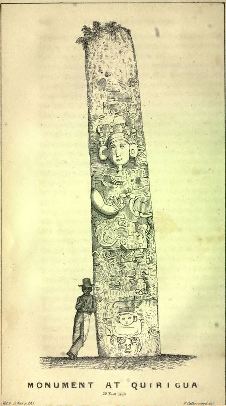
Mayan Stela drawn by Frederick Catherwood. One of many large carved stones
at Quirigua
…
Now for the “word of the Lord”
(LDS D&C 127:10) published in the
same issue, and later canonized as LDS D&C 128:
TIMES
AND SEASONS.
CITY OF
NAUVOO,
SATURDAY, OCTOBER 1, 1842.
LETTER
FROM JOSEPH SMITH.
Nauvoo, September 6, 1842.
TO THE
CHURCH OF JESUS CHRIST OF LATTER DAY SAINTS,
SENDETH GREETING:-
As I
stated to you in my letter before I left my place, that I would write to you
from time to time, and give you information in relation to many subjects, I
now resume the subject of the baptism for the dead; as that subject seems to
occupy my mind, and press itself upon my feelings the strongest, since I
have been pursued by my enemies.
I wrote
a few words of Revelation to you …
…those
things which never have been revealed from the foundation of the world, but
have been kept hid from the wise and prudent, shall be revealed unto babes
and sucklings in this the dispensation of the fulness
[fullness]
o f times.-Now what do we hear in the gospel which we have
received? "A voice of gladness! A voice of mercy from Heaven; and a voice of
truth out of the earth, glad tidings for the dead: a voice of gladness for
the living and the dead; glad tidings of great joy; how beautiful upon the
mountains are the feet of those that bring glad tidings of good things; and
that say unto Zion, behold! thy God reigneth. As the dews of
Carmel, so shall the knowledge of God descend upon
them. And again, what do we hear? Glad tidings from
Cumorah! Moroni,
(page
935)
an Angel
from heaven, declaring the fulfilment
[fulfillment]
of the
prophets-the book to be revealed.
A voice of the Lord in the wilderness of Fayette, Seneca county,
declaring the three witnesses to bear record of the book. The voice
of Michael on the banks of the Susquehanna, detecting the devil when
he appeared as an angel of light. The voice of Peter, James and John, in the
wilderness between Harmony, Susquehanna county, and Colesville, Broom
county, on the Susquehanna River, declaring themselves as possessing
the keys of the kingdom, and of the dispensation of the fulness
[fullness]
of times. And again, the voice of
God in the chamber of old father Whitmer, in Fayette, Seneca county …
“Cumorah”, not the hill Cumorah, is mentioned. It was at the Smith family
cabin in the Book of Mormon land Cumorah (Mormon 6:5, 1981 edition or
earlier) that Moroni
declared the fulfillment of the words of several Jewish Prophets, and the
coming forth of the Book of Mormon.
(Joseph Smith-History 1:36-41)
Let the
mountains shout for joy, and all ye valleys cry aloud; and all ye seas and
dry lands tell the wonders of your eternal King. And ye rivers, and brooks,
and rills, flow down with gladness. Let the woods, and all the trees of the
field praise the Lord: and ye solid rocks weep for joy…
Brethren, I have many things to say to you on the subject; but shall now
close for the present, and continue the subject another time.
I am, as
ever, your humble servant and never deviating friend.
JOSEPH
SMITH.
Unlike the unsigned “ZARAHEMLA” piece, Joseph’s letter bears his name. No
question here as to who authored the epistle to the Church that became LDS
D&C 128. The Prophet’s epistle with its psalm of Carmel and Cumorah is even
recorded in his Journal.
Leave it to 20th Century
RLDS members, who dismissed the practice
of “baptism for the dead”, to be the first to concoct the idea of a
“Cumorah” in southern
Mexico
– proximal to Stephens finds. [3] It would take foolish LDS, like
Thomas Fergusson, to concur with the quasi-limited RLDS geography, and then
years later, blame his disappointment on Joseph Smith. [4]
Joseph’s
psalm mentions “seas … dry lands … rivers … brooks
and rills …” but, the word lakes is not used. Large
bodies of water, including those in the western NY region of Cumorah,
qualify as “seas” in the biblical sense. With Cumorah at Cumorah, it becomes
clear that the Finger Lakes region is a Book of Mormon “land of many
waters”. Lake Ontario connecting with the St Lawrence channel, is the modern remnant of the
exceedingly large “waters of Ripliancum” (pointed out in the
1879 LDS edition of the
Book of Mormon
- see Ether 15:8, footnote c).
You can trust those footnotes in the 1879 edition, that are backed by
scripture!
Throw out Orson Pratt’s
missionary minded but
unscriptural hemispheric
stretches. It should become very clear that the Book of Mormon “west
sea” has to be “Lake Erie” - that large body of water at the western end of
Joseph Smith’s boyhood state of NY. Its Plain! Its Simple! Its not thousands of miles
removed! But wait, doesn't the Book of Mormon say that "the land
northward", with its "large bodies of water and many rivers", was "an
exceedingly great distance" from Zarahemla?
(Helaman 3:3-4)
Yes. These verses are describing Canada. An "exceedingly great distance" can simply mean hundreds of miles by boat
and overland
from
NY's
Erie coast. Ontario Canada
fits perfectly the description of a "land northward" bounded in each of the
cardinal directions by inland seas.
(Helaman 3:8)
Try finding a consistent match for that
northwest of Tehuantepec.
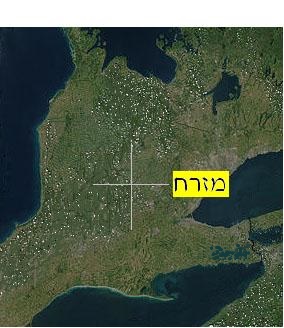
Ontario Canada (Helaman 3:8)
Note: "sea south" etc. simply means sea on the south. It is not the
name of the sea.
The Finger Lakes "land of many waters"
(near Cumorah) is eastward from the small isthmus known to geologists as the
Batavia Moraine.
(Ether 7:5-6;
9:3,
14:11,
26) So the "small neck",
"pass" or "passage" with waters of a "sea" (singular) "on the west and on the east"
of it, is not a continental isthmus after all!
(Alma 50:34)
It's a local New York moraine that passes through an ancient seabed that
goes by the Indian name Tonawanda. Lake Tonawanda was an extension of the Book of Mormon
"sea" that "divides that land"
(Ether 10:20)
- but scripture doesn't indicate that such was the
name of "the sea". Lake Tonawanda extended eastward from what is now the Niagara river. The
inland sea therefore
constituted a shallow arm or appendage of
the Book of Mormon "west
sea" - ancient Lake Erie. Lake Tonawanda invaded the land of Desolation
(lower in elevation compared to the
southern land of Bountiful,
Alma 22:30-31). Lake Tonawanda
is not
altogether gone, but exists today as marshlands. A modern road through the
wetlands has been paved
on top of the ancient moraine.
See The
Divided
Neck.
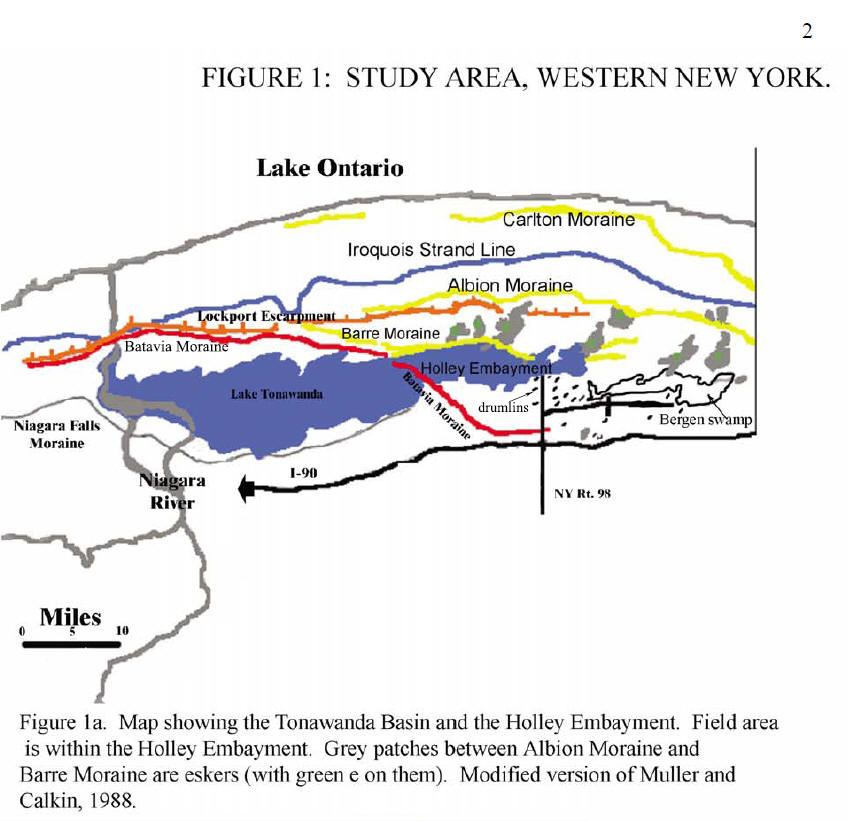
The narrow Batavia Moraine (in red)
passing through a shallow, ancient
arm of the “west sea”, Lake Erie. (Fig. 1, Natel, Heidi Harlene,
Proglacial Sedimentology and Paleoecology of the Tonawanda Basin, Western
New York: Implications for a Late Wisconsinian Progalcial Environment,
Master’s Thesis, State University of New York, College at Oneonta, figure
1a, pg. 2.) Other Moraine like structures closer
to the Niagara River, were submerged, leaving only the Batavia Moraine (at
the Lake’s
shallower eastern end) to divide the inland sea into
its effluent western and more stagnant eastern parts.
As for those unsigned articles; should you suppose that Joseph Smith’s name
at the end of the newspaper authorizes everything in the issue – think
again. Ask yourself, why do some articles have his “ED” and others do not?
Why explicitly print his name at the end of his epistle and leave the
“ZARAHEMLA” article unsigned? The short answer is, the Prophet didn’t write
the “ZARAHEMALA” article, or any of the unsigned articles. [5] Joseph wasn’t the only one who wrote
long sentences; and who knows who wrote
and edited what in the unsigned articles. They come across as an anonymous
joint effort.
Here is how previous editions of the Times and Seasons (in which
Joseph Smith personally acted as editor) end:
The Times and Seasons, IS EDITED BY Joseph Smith. Printed and
published about the first and fifteenth of every month, on the corner of
Water and Bain Streets, Nauvoo,
Hancock County, Illinois,
by JOSEPH SMITH.
Articles Joseph personally authored and or endorsed, he signed “ED”. The
October 1, 1842 edition on the other hand, containing the “ZARAHEMLA” article
and the Prophet’s letter to the Church, ends this way:
The
Times and Seasons, Is edited, printed and published about the first and
fifteenth of every month, on the corner of Water and Bain Streets, Nauvoo,
Hancock County, Illinois, by JOSEPH SMITH
See the difference? As the Prophet’s September 1, 1842 letter (LDS D&C
127) points out, Joseph had left his affairs with others. So Joseph’s name
appearing at the end of the newspaper issue should not be construed as
lending prophetic weight to the unsigned “ZARAHEMLA” piece. The newspaper
article is nothing more than overreaching, provocative press - with,
of course,
the good
intent of bolstering faith in the Book of Mormon.
Why wasn’t the newspaper article signed? Did this have anything to do with
the Prophet keeping a low public profile at the time? If that’s the complete
answer, how then do we account for the fact that after Joseph had resumed
public life, after he had relinquished the title of T&S editor, the
Times and Seasons came out with yet another presumptuous article
entitled “STEPHENS’ WORKS ON CENTRAL AMERICA” (October 1, 1843) - on the
anniversary of the “ZARAHEMLA” article’s publication. The authors again were
anonymous. But by this time they had done a little more reading. They admit
that they “have lately perused with great interest, Stephen's
works on Central America,
Chiapas, and Yucatan…
published in two volumes…”
Still not confronting the problem posed by Stephens’ dating of the Central
American ruins, the anonymous authors launch into promoting Stephens’ latest
work (Incidents of Travel in Yucatan) as an essential guide to Book of Mormon cities “that ought to be
in the hands of every Latter Day Saint…”
How about better studying the Book of
Mormon first?
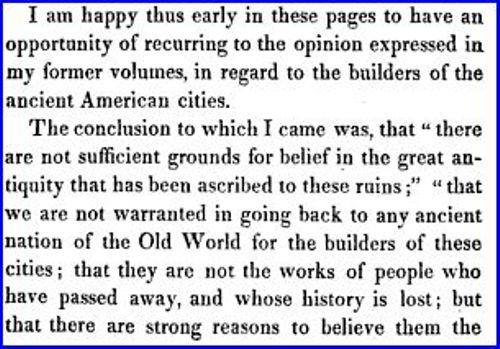
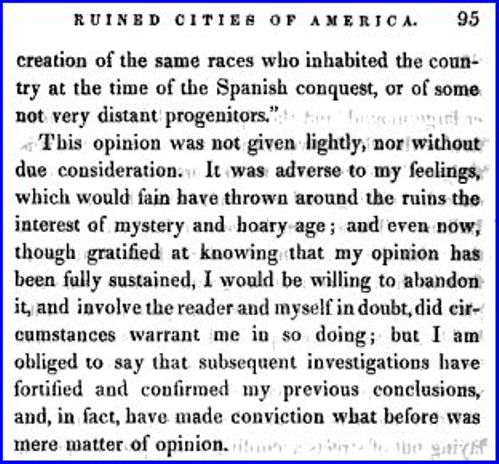
John Lloyd Stephens, Incidents of Travel in
Yucatan, vol. 1, Ch. IV, pp. 94-95 (1843)
Its telling that when John Taylor cites the Prophet Joseph Smith relative to
Stephens’ works, he paraphrases and embellishes words from Joseph Smith’s
signed, July 15, 1842 American Antiquities article. (See John Taylor, Journal of
Discourses, Vol. 5, pg. 241, The Gospel Kingdom,
pg. 357) He doesn’t attribute any of the unsigned articles to Joseph Smith.
In the
American Antiquities article,
Joseph blatantly places Book of Mormon events in temperate North America – in mound builder country. Joseph appears
to agree with Priest, that the descendents of ancient peoples from temperate
North American eventually migrated to Mexico and beyond. “Their ruins
speak of their greatness; the Book of Mormen [Mormon] unfolds their
history.-ED.” (“American Antiquities”, T&S July 15, 1842)
Joseph’s statement is true in the same sense that the Bible contains the
history of the Jews - even for Jews who migrated to Poland. Joseph
Smith never says that Book of Mormon lands are in
Central America or that the “stupendous ruins” Stephens and
Catherwood found there, date to Book of Mormon times. Joseph knew
better than to do that.
The newspaper issue containing the unsigned “STEPHENS’ WORKS ON CENTRAL
AMERICA” ends thus:
The
Times and Seasons, is edited by JOHN TAYLOR. Printed and published about the
first and fifteenth of every month, on the corner of Water and Bain Streets,
Nauvoo, Hancock County, Illinois, by JOHN TAYLOR AND WILFORD
WOODRUFF.
Shortly after publishing “STEPHENS’ WORKS ON CENTRAL AMERICA”, Elder
Woodruff found occasion to do a little more than “peruse” Stephens’ latest
book. His October 17, 1843 journal entry reads:
“I have been for the last two days reading Stephens works & travels in
Yucatan
his second work. I red his first work on my Journey to Nauvoo with family in
1841. I found them highly interesting & also the present work. It is a great
proof of the truth of the Book of Mormon. I read them with the highest
degree of interest.” (2:319)
Elder Woodruff had formed his own strong opinion about Stephens’ and
Catherwood’s discoveries even before Joseph had the chance to thoroughly
read the bestseller. In fact, Elder Woodruff was the one who brought a copy
of Stephens’ two volume work to Joseph. Elder Woodruff's journal makes no mention of Joseph
Smith’s opinion on the subject.
Additional References:
[1] The Personal Writings of Joseph Smith, compiled and edited by
Dean C. Jessee, S.L.C, Deseret Book, 2002, pg. 533
[2] John Lloyd Stephens, Incidents of Travel in
Central America, Chiapas and
Yucatan, Vol. I, pp. 97-98
[3] Louis Edward Hills (RLDS), Geography of Mexico and Central America
from 2234 B.C. to 421 A.D., Independence, MO, 1917; Jeremiah F.
Gunsolley, “More Comment on Book of Mormon Geography,” Saints Herald
69/46 (1922), pp. 1074-1076
[4] Hampton Sides, “This Is Not the Place”, Double Take Magazine,
Vol. 5, No 2; also included in his work ''American: Dispatches from the
New Frontier'', 2004
[5] Matthew Roper,
“Limited Geography and
the Book of Mormon: Historical Antecedents and Early Interpretations”,
section titled "John Taylor's View", BYU
Maxwell Institute, 2004.
Brother Roper
attributes the unsigned articles, including the “ZARAHEMLA” piece to
acting editor John
Taylor.
You may also want to read
WINCHESTER
SMOKE
- Targeting Book of Mormon Geography Scapegoats!
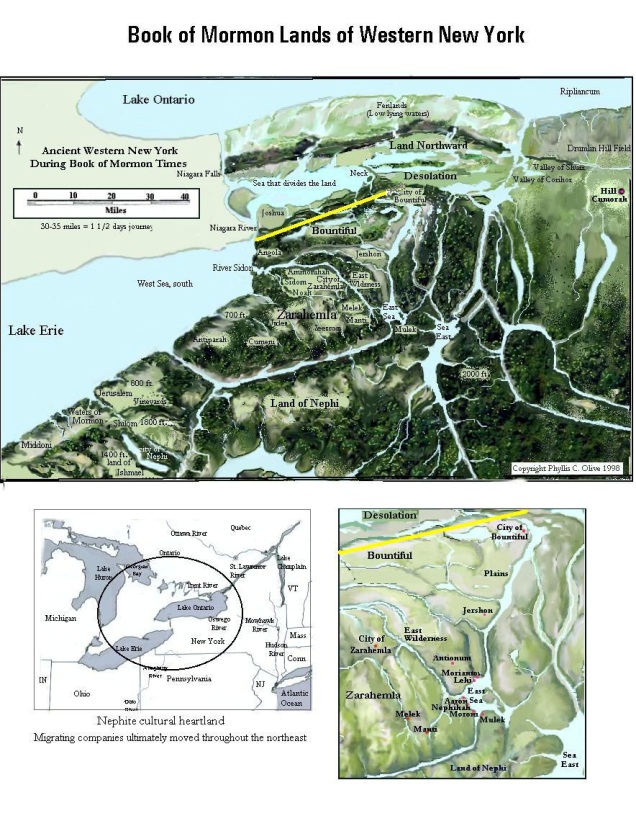
The NEAR CUMORAH LITERARY SETTING

Vincent Coon
וִינְסֶנט כּוּן
כ
© Copyright 2015
|